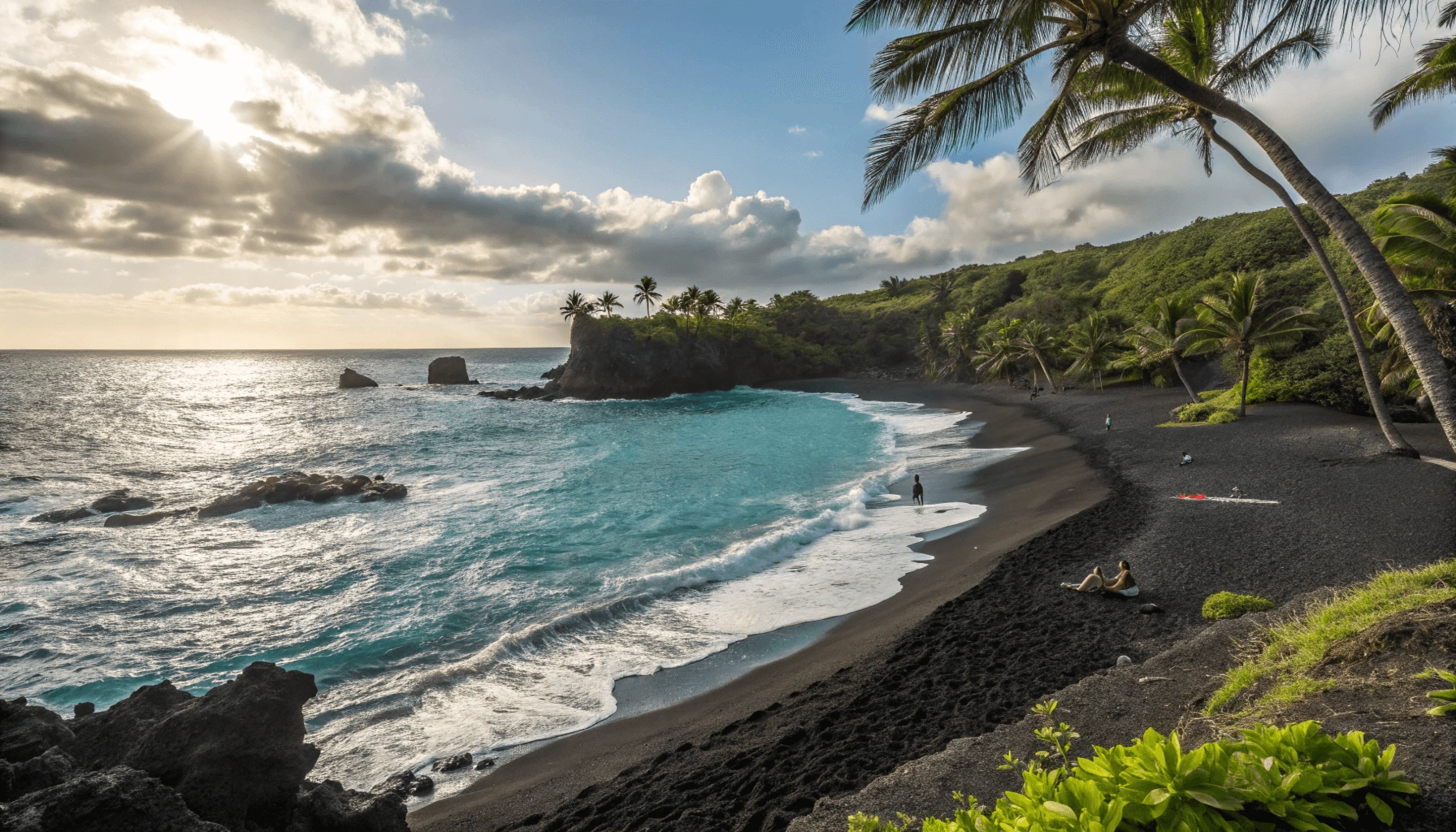The first time I set foot on 49 Black Sand Beach, I was struck by the stark contrast between the glistening black granules beneath my feet and the crystal-clear turquoise waters stretching out before me. Hidden away behind a gated community on the Kohala Coast, this secluded gem offers one of the Big Island’s most rewarding snorkeling experiences and a peaceful escape from Hawaii’s more crowded shores.
This comprehensive guide will walk you through everything you need to know about visiting 49 black sand beach hawaii (Honokaʻope Beach) – from securing those coveted access passes to discovering the vibrant underwater world that makes this spot so special.
Table of Contents
Quick Facts About 49 Black Sand Beach
| Feature | Details |
|---|---|
| Official Name(s) | 49 black sand beach hawaii, Honokaʻope Beach |
| Location | Mauna Lani Resort area, Kohala Coast, Big Island |
| GPS Coordinates | 19.9519° N, 155.8608° W |
| Access | Gated community with limited daily passes |
| Best For | Snorkeling, seclusion, unique black sand |
| Amenities | Basic restrooms, outdoor shower |
| Crowd Factor | Low to moderate (highest midday) |
| Parking | Limited (approximately 15 spaces) |
The Story Behind the Name: Why “49”?
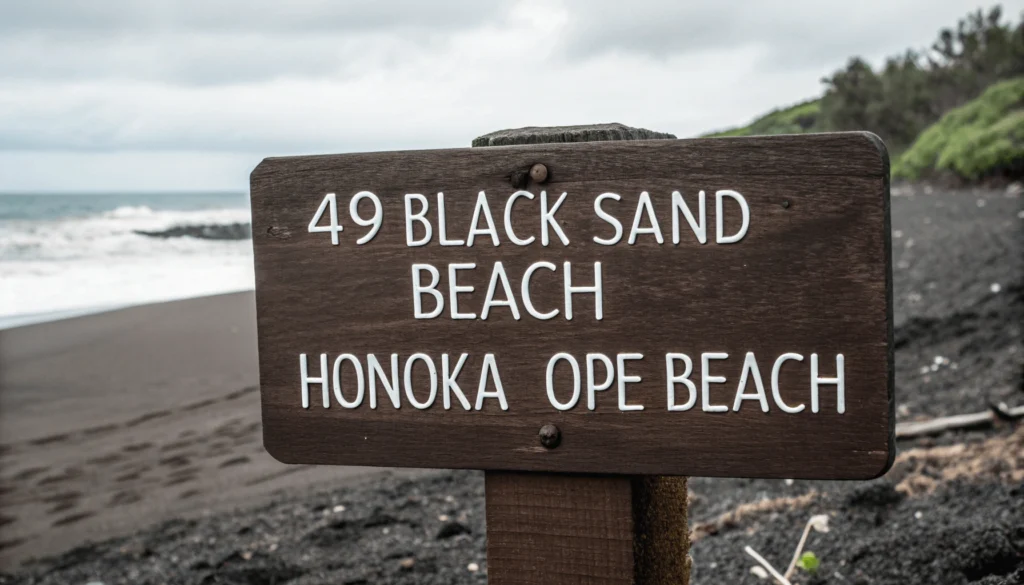
Unlike many Hawaiian beaches named for their geographical features or historical significance, 49 Black Sand Beach got its practical moniker from the original lot number designation when the Mauna Lani Resort area was being developed. Local residents and early visitors began referring to it as “Beach 49” or simply “49,” and the name stuck.
Some long-time Big Island residents will tell you stories about visiting “Lot 49 Beach” long before the resort development, when it was even more secluded and pristine. While its Hawaiian name, Honokaʻope, is actually the historically accurate name (meaning “the beach of the shrimp” in Hawaiian), most visitors and locals continue to use the numerical nickname that has become part of local lore.
Getting There: Your Complete Access Guide
The uniqueness of 49 black sand beach hawaii isn’t just in its striking volcanic sand – it’s also one of the few beaches on the Big Island with a controlled access system. Here’s exactly how to get there from major points around the island:
Driving Directions
From Kailua-Kona (approximately 30-35 minutes):
- Head north on Highway 19 (Queen Kaʻahumanu Highway)
- Continue for about 23 miles
- Turn right at the Mauna Lani Resort entrance
- Follow the signs to the Mauna Lani Beach Club
- You’ll reach the security gate where passes are distributed
From Waikoloa (approximately 15 minutes):
- Head south on Highway 19
- Drive approximately 5 miles
- Turn left at the Mauna Lani Resort entrance
- Follow resort signs to the Mauna Lani Beach Club
- Proceed to the security gate
From Hilo (approximately 1 hour 45 minutes):
- Take Highway 19 north
- Continue through Waimea
- Follow Highway 19 south along the Kohala Coast
- Turn left at the Mauna Lani Resort entrance
- Follow signs to the Mauna Lani Beach Club
The Gate & Beach Pass System: What You MUST Know
The most crucial piece of information for visiting 49 Black Sand Beach is understanding the pass system. The beach is located within the Mauna Lani Resort property, and access is controlled to preserve its natural beauty and prevent overcrowding.
How the Pass System Works:
- A limited number of passes (typically 15-20) are distributed daily at the security gate
- Passes are available on a first-come, first-served basis starting at 9:00 AM
- Each pass admits one vehicle, not per person
- Passes must be returned when leaving
- No reservations are accepted – it’s completely day-of
The Early Bird Strategy (HIGHLY Recommended):
- Arrive by 8:30 AM to queue for a pass, especially during high season (December-April)
- During summer months, passes may be gone by 10:00 AM
- On holiday weekends, consider arriving even earlier (8:00 AM)
What If Passes Are Gone?
- Ask the gate attendant what time people typically return passes (often early afternoon)
- Explore nearby Mauna Lani beaches in the meantime (Makaiwa Bay is excellent)
- Return later when passes might be available again
- Have a backup beach plan (Hapuna Beach or Waialea/Beach 69 are good alternatives)
For Resort Guests: If you’re staying at the Mauna Lani Resort or have a dinner reservation at the resort restaurant, you may receive priority for beach access. Always mention your status when requesting a pass.
Parking at 49 Black Sand Beach
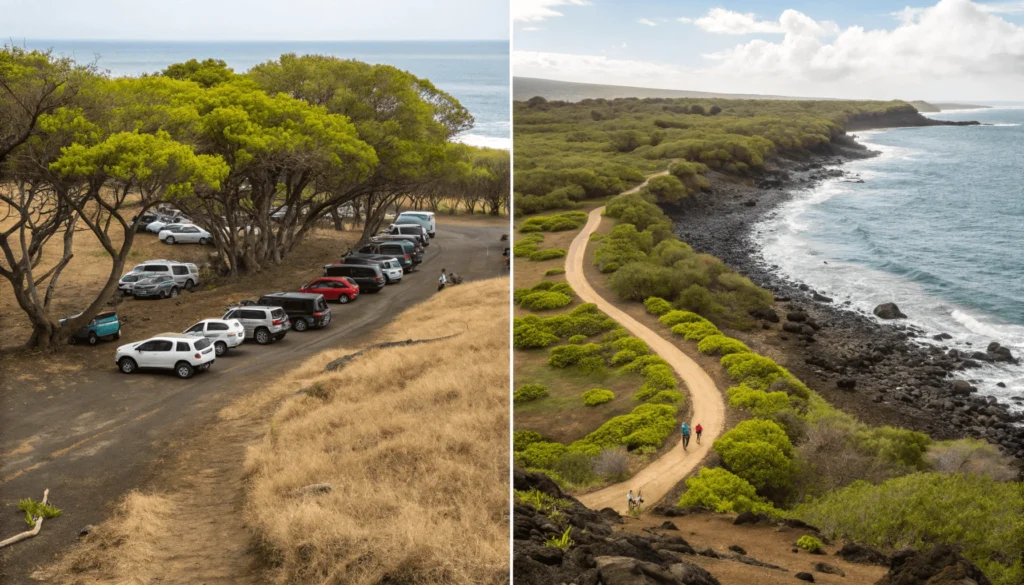
Once you’ve secured your coveted pass, you’ll be directed to the small parking area designated for 49 Black Sand Beach visitors.
Parking Details:
- Small lot with approximately 15 marked spaces
- Located about 200 yards from the beach access point
- Partially shaded by kiawe trees (be careful of thorns!)
- No overflow parking available
Parking Tips:
- Pack efficiently so you can carry all your gear in one trip
- Don’t leave valuables visible in your vehicle
- Note your parking spot location – the lot can be confusing when returning
- If the designated lot is full, you’ll need to wait for someone to leave
The Walk to the Beach
After parking, you’ll follow a well-trodden path to reach the beach:
- The trail is approximately 200-250 yards long
- Surface is mostly packed dirt with some lava rock
- Not wheelchair accessible or ideal for those with mobility issues
- Moderate shade along portions of the path
- Watch for kiawe thorns that may have fallen on the path (closed-toe shoes recommended)
- The path opens up to reveal the striking black sand beach
What to Expect at 49 Black Sand Beach
The Sand
49 Black Sand Beach isn’t your typical jet-black sand beach like Punaluʻu on the southern end of the island. Instead, it features what locals call a “salt and pepper” mix – predominantly black volcanic particles interspersed with lighter fragments of coral and shell.
The sand here is:
- Coarser than regular beach sand
- Darker near the shoreline where it stays wet
- Surprisingly not as hot underfoot as white sand
- Created from volcanic activity and ocean erosion
- Unique to this particular cove
The texture is noticeably different from other Hawaiian beaches – slightly more coarse and sparkly when wet, with tiny olivine crystals occasionally visible if you look closely.
The Water
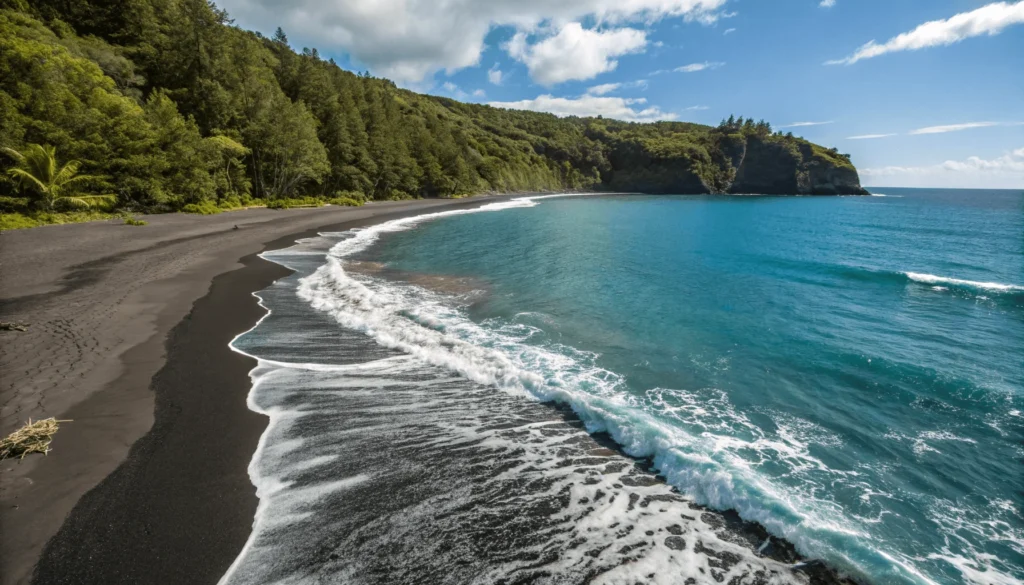
The ocean at 49 Black Sand Beach is what truly makes this spot special:
- Exceptionally clear visibility (often 30+ feet on calm days)
- Vibrant turquoise color, especially on sunny days
- Generally calm in the morning hours
- Protected cove formation reduces wave action
- Water temperature typically 75-80°F year-round
- Gentle entry on the south end, rockier on the north end
The beach sits in a relatively protected cove, making the water conditions typically calmer than at more exposed beaches along the Kohala Coast. However, always check conditions upon arrival, as winter swells can occasionally impact this area.
Shade & Beach Layout
The beach itself is a curved stretch approximately 200 yards long:
- Limited natural shade from kiawe trees along the back of the beach
- Best shade spots are typically claimed early
- Beach width varies from 15-40 feet depending on tide
- North end features interesting lava rock formations
- South end has the gentlest water entry point
- Central area usually has the most open sand for setting up
Kiawe Tree Warning: While the kiawe trees provide welcome shade, they drop needle-sharp thorns that can easily puncture bare feet or beach mats. Always inspect your spot before settling in, and consider bringing a beach umbrella for safer shade.
Wildlife at 49 Black Sand Beach
One of the highlights of visiting this beach is the abundant marine life:
- Hawaiian green sea turtles (honu) frequently rest on shore
- Spinner dolphins occasionally visit the bay in the morning
- Diverse reef fish visible even from shore
- Coral formations begin close to the beach entry points
Turtle Viewing Etiquette: Green sea turtles in Hawaii are protected under the Endangered Species Act and the Marine Turtle Protection Act, as outlined by NOAA.
- Always maintain at least 10 feet distance from resting turtles
- Never touch, chase, or block a turtle’s path
- Photos are fine from a respectful distance
- It’s against federal law to harass or disturb sea turtles
Activities at 49 Black Sand Beach
Snorkeling – The Main Attraction
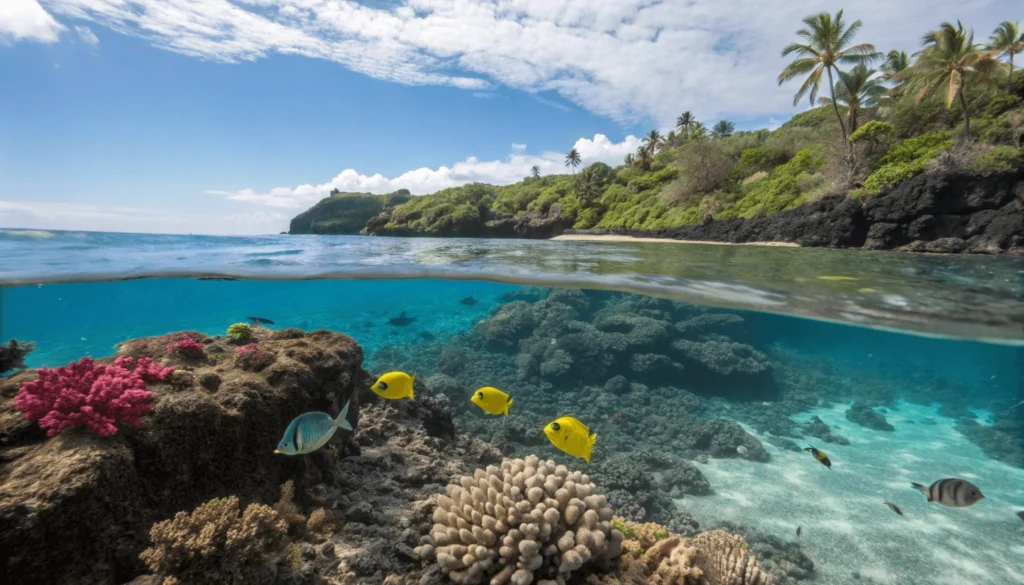
49 Black Sand Beach offers some of the best shore snorkeling on the Big Island, rivaling even the famous Kealakekua Bay in marine diversity.
Best Snorkeling Entry Points:
- South Entry: The gentlest slope with sandy bottom, ideal for beginners
- Central Entry: Small channel through rocks, provides quick access to deeper reef
- North Entry: For experienced snorkelers only, rocky but rewards with immediate reef access
What You’ll See Underwater:
- Vibrant coral formations starting just 15-20 feet from shore
- Common tropical fish species including:
- Yellow tang
- Moorish idol
- Hawaiian state fish (humuhumunukunukuāpuaʻa)
- Parrotfish
- Butterflyfish
- Needlefish
- Occasional encounters with:
- Green sea turtles
- Moray eels (in rock crevices)
- Octopus (if you’re patient and observant)
- Small reef sharks (rare but sometimes seen in deeper water)
Snorkeling Safety Tips:
- Always snorkel with a buddy
- Check conditions before entering – if the water is murky or rough, save it for another day
- Wear reef-safe sunscreen or, better yet, a rash guard for sun protection
- Never touch or stand on coral (it’s both harmful to the reef and potentially painful)
- Entry and exit points can be rocky – water shoes are highly recommended
- Morning typically offers the calmest conditions and best visibility
The reef extends throughout most of the cove, with the best coral formations in the 5-15 foot depth range about 30-50 yards from shore. The diversity of fish life is impressive even by Hawaiian standards, making this a must-do activity when visiting.
Swimming
Swimming at 49 Black Sand Beach is generally excellent due to the protected nature of the cove:
- The south end offers the gentlest entry
- Center area deepens gradually to about 6 feet
- Northern section deepens more quickly
- Minimal current most days, especially in morning hours
- Water clarity makes for enjoyable swimming
- No lifeguards on duty – swim at your own risk and know your limits
Sunbathing & Relaxing
The intimate size and secluded nature of 49 Black Sand Beach make it perfect for a peaceful day of relaxation:
- The dark sand creates interesting thermal properties – cooler in the morning but can get hot midday
- Bring a good beach mat or chair as the sand is coarser than typical beaches
- Best relaxation spots are along the tree line for occasional shade
- The beach rarely feels crowded due to the pass system
- Ambient sounds are mostly natural – waves, wind, and birds rather than crowds
Photography Opportunities
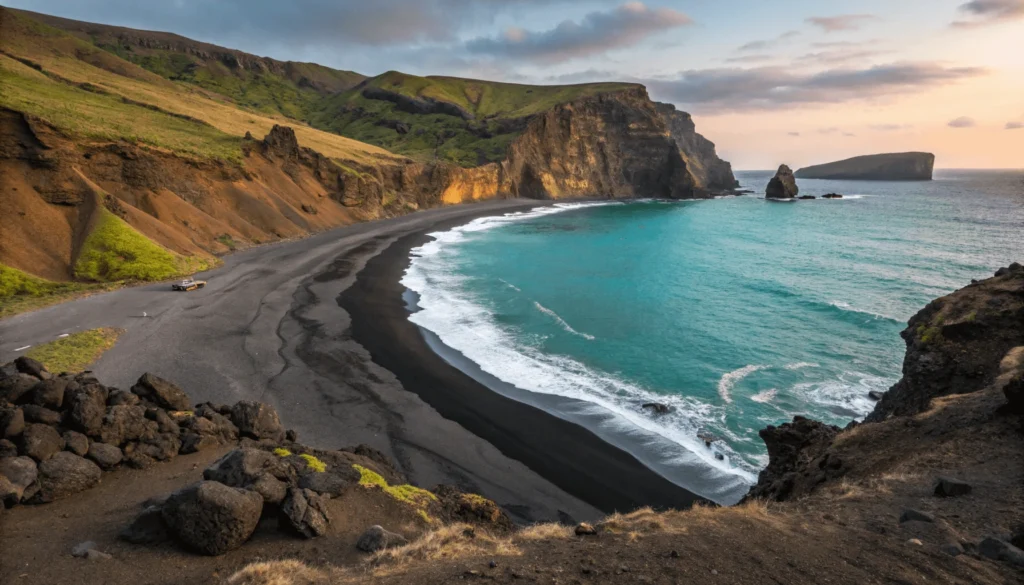
Photographers will find numerous compelling compositions at 49 Black Sand Beach:
- The contrast between black sand and turquoise water is striking
- Early morning light (8-10 AM) provides the best illumination of the water colors
- Lava rock formations at the north end create interesting foreground elements
- Sunset is not directly visible (the beach faces east), but late afternoon light creates beautiful warm tones
- Underwater photography is excellent due to water clarity
Essential Tips for Your 49 Black Sand Beach Visit
What to Bring – The Complete Packing List
Being prepared will significantly enhance your experience at this somewhat remote beach:
Beach Essentials:
- Beach towels or mat (thicker than usual to cushion the coarser sand)
- Beach umbrella (recommended due to limited natural shade)
- Reef-safe sunscreen (required by Hawaii law)
- Hat and sunglasses
- Water shoes (highly recommended for rocky entries)
- Small cooler with plenty of water and snacks (no food services nearby)
- Trash bags (pack out everything you bring in)
Snorkeling Gear:
- Mask, snorkel, and fins (bring your own for best fit)
- Rash guard or swim shirt for sun protection
- Underwater camera if you have one
- Dry bag for electronics
- Anti-fog solution for mask
Additional Recommended Items:
- First aid kit including tweezers (for potential kiawe thorns)
- Insect repellent (occasional issue near tree line)
- Change of clothes for the drive back
- Small backpack for the walk from parking lot
- Binoculars for spotting dolphins offshore
Best Time to Visit
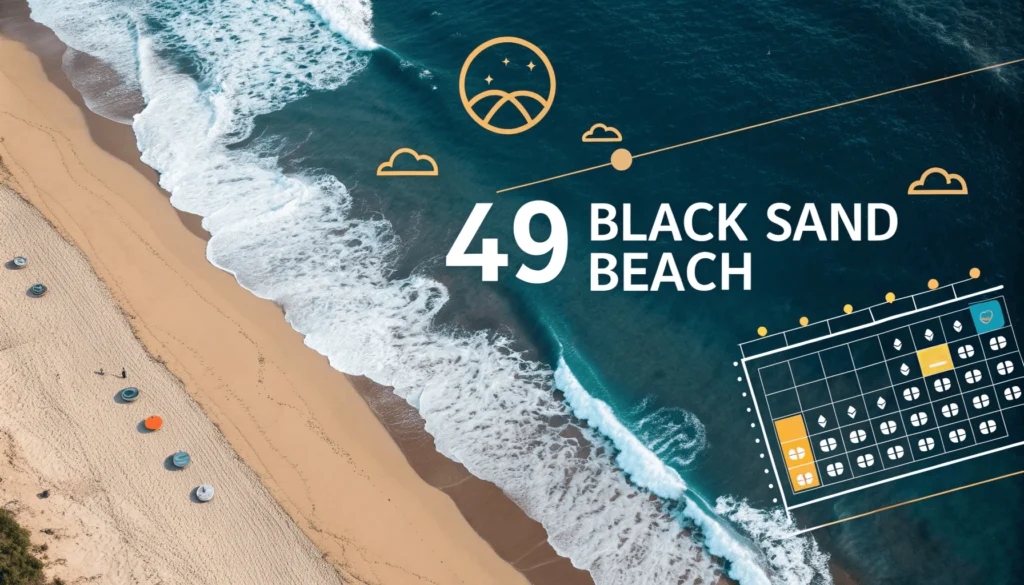
Timing can make a significant difference in your experience:
Time of Day:
- Early morning (8-10 AM): Best for pass acquisition, calmest water, excellent snorkeling visibility
- Midday (11 AM-2 PM): Brightest colors but can be hot with minimal shade
- Afternoon (2-5 PM): Often less crowded as morning visitors depart, but sometimes windier
Best Days:
- Weekdays are significantly less crowded than weekends
- Avoid major holidays if possible
- Winter months (December-April) see more visitors but also have more whale sightings offshore
- Summer months offer the calmest water conditions on average
Safety Precautions at 49 Black Sand Beach
While generally safe, there are some specific considerations for this location:
- Ocean Awareness: No lifeguards are present – know your swimming abilities
- Kiawe Thorns: Extremely sharp thorns from kiawe trees can cause painful punctures
- Sun Exposure: Limited shade makes sun protection crucial
- Hydration: No water sources at the beach – bring plenty
- Marine Life Safety: Maintain distance from turtles and marine creatures
- Lava Rock: Some areas have sharp lava rock underwater – use caution when walking
- Isolation: Cell service can be spotty – have emergency plans
- Theft Prevention: Don’t leave valuables in your car or unattended on the beach
Malama ʻĀina: Caring for the Land
The beauty of 49 Black Sand Beach is preserved through responsible visitation:
- Leave No Trace: Pack out all trash and belongings
- Reef Protection: Never stand on or touch coral formations
- Wildlife Respect: Maintain proper distance from all marine creatures
- Cultural Sensitivity: Respect any cultural sites or practices you may encounter
- Resource Conservation: Use water sparingly at the outdoor showers
- Stay on Trails: Use only established paths to access the beach
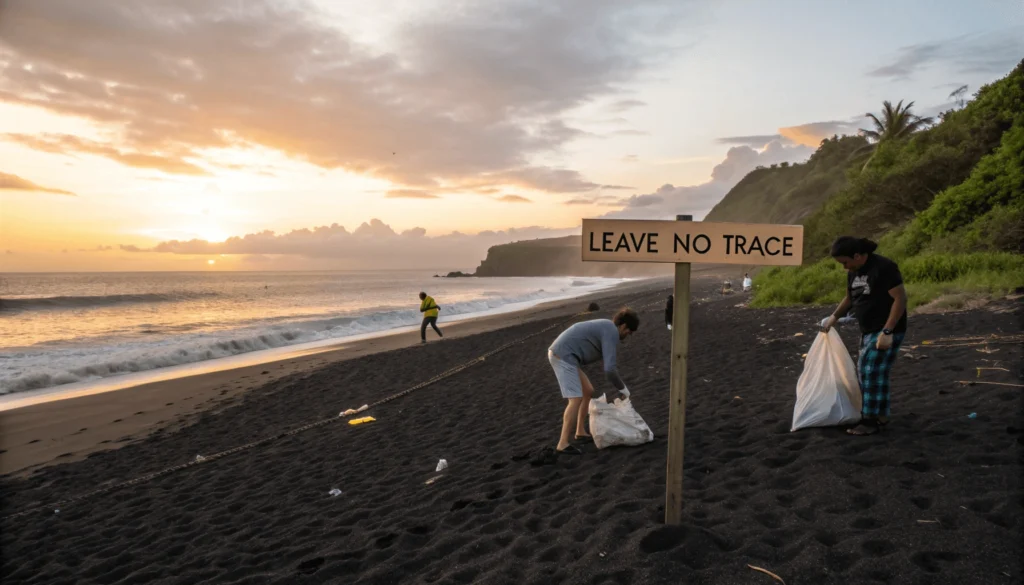
On-Site Amenities
Facilities at 49 Black Sand Beach are minimal but adequate:
- Restrooms: Basic portable toilets near the parking area (not beach-adjacent)
- Showers: Simple freshwater rinse shower for after swimming
- Trash Disposal: Small bins near parking area (often full – be prepared to pack out)
- No Food/Drink Services: Nothing available on-site
- No Equipment Rentals: Bring all necessary gear
Cell Service
Connectivity at the beach is inconsistent:
- Spotty coverage for most carriers
- Best reception is typically at higher points near the parking area
- Don’t rely on phone service for navigation or emergencies
Photography & Videography Showcase
The unique characteristics of 49 Black Sand Beach make it a photographer’s dream. The contrast between the dark sand and bright turquoise water creates striking images, especially in morning light when the sun illuminates the underwater reef.
For the best photographic results:
- Shoot during the golden hour (early morning) for warm light and calm water
- Use polarizing filters to cut glare and enhance underwater visibility
- Capture the texture of the sand up close to show its unique composition
- Include snorkelers in wider shots to show scale and the popularity of the activity
- Position at the north end looking south for the most comprehensive beach views
Nearby Attractions & Amenities
Make the most of your day by combining your 49 Black Sand Beach visit with these nearby offerings:
Other Mauna Lani Beaches
- Makaiwa Bay: Just north of 49, easier access but still excellent snorkeling
- Pauoa Bay: Home to the Fairmont Orchid, beautiful white sand beach
Shopping & Dining
- The Shops at Mauna Lani: Located 5 minutes away with:
- Foodland Farms grocery store (great for beach picnic supplies)
- Tommy Bahama Restaurant
- Ruth’s Chris Steakhouse
- Casual dining options
- Coffee shops and ice cream
Cultural Sites
- Kalahuipuaʻa Fishponds: Ancient Hawaiian fish ponds within walking distance
- Puakō Petroglyph Archaeological Preserve: One of the largest collections of Hawaiian petroglyphs, just a short drive away
Practical Services
- Gas station at the Shops at Mauna Lani
- ATM services
- Gift shops for forgotten beach essentials
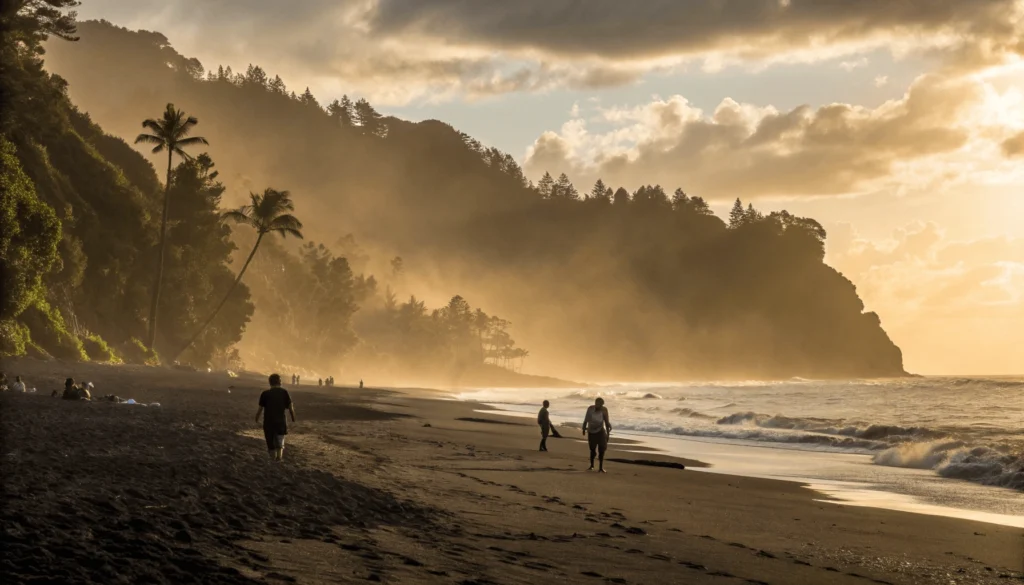
Frequently Asked Questions About 49 Black Sand Beach
Is 49 Black Sand Beach good for children?
Yes, but with supervision. The south end of the beach has a gentle entry and protected waters suitable for children who can swim. The lack of lifeguards means parents should remain vigilant, and the walk from the parking area may be challenging for very young children.
Are dogs allowed at 49 Black Sand Beach?
No, pets are not permitted at 49 Black Sand Beach as part of the conservation efforts to protect the delicate ecosystem and wildlife.
How many parking passes are available daily?
Typically 15-20 passes are distributed each day, depending on beach conditions and staffing. This number may vary seasonally.
Is there an entrance fee for 49 Black Sand Beach?
There is no direct fee for beach access, but you must obtain a free pass from the security gate, which is limited and first-come, first-served.
Can you walk to 49 Black Sand Beach from nearby resorts?
Technically yes, but it’s discouraged. While guests at the Mauna Lani Resort could potentially walk to the beach along the coast, the access system is designed for visitors to check in at the gate. Walking in from other areas may be considered trespassing on private property.
What makes 49 Black Sand Beach different from other black sand beaches on the Big Island?
Unlike Punaluʻu or other black sand beaches created by recent lava flows, 49 Black Sand Beach has a unique “salt and pepper” mix of black volcanic sand and lighter fragments. It’s also known for exceptional snorkeling and is more protected than many other black sand beaches.
When is the best time of year to visit 49 Black Sand Beach?
The beach is enjoyable year-round, but May through October typically offers the calmest ocean conditions. Winter months (December-April) may have occasional larger swells but provide opportunities for whale watching from shore.
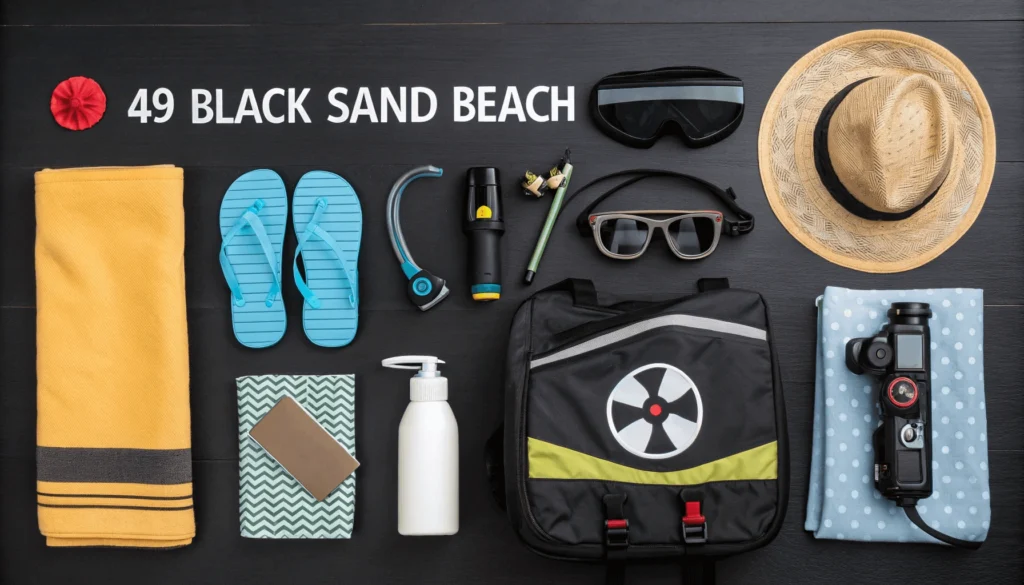
Conclusion: Why 49 Black Sand Beach Deserves Your Visit
49 Black Sand Beach represents the perfect blend of natural beauty, accessibility (albeit limited), and authentic Hawaiian coastal experience. Its controlled access system – while potentially frustrating if you arrive too late – ultimately preserves the tranquil atmosphere that makes this beach so special.
The combination of distinctive black sand, extraordinary snorkeling, and relatively uncrowded environment creates a beach experience that captures the essence of old Hawaii, even within a resort area. Making the effort to secure a pass and discover this hidden gem rewards visitors with memories that will last long after the sand has been washed from their feet.
Have you been to 49 Black Sand Beach? Share your tips and experiences in the comments below! And if you found this guide helpful, please share it with fellow travelers planning their Big Island adventure.
Remember to malama the ʻāina (care for the land) during your visit by leaving no trace and treating this special place with the respect it deserves.
Last updated: May 2025 – Beach access procedures and conditions may change. Always check with local authorities or your accommodation for the most current information.

